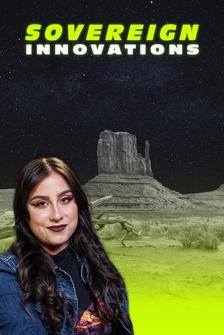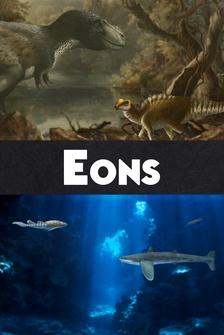Maiya: Nearly two centuries ago, when their territories were colonized, Native Americans began to settle in Isle de Jean Charles, way out on the edge of Louisiana.
Now extreme weather and coastal erosion force them to make an impossible decision: to rebuild or to relocate.
Is this it?
Yeah, that's what's left of it.
This is your home?
Yep.
[music] Nobody actually wanted to leave the island.
In their own situation, they had no other choice but to leave.
Broadcaster: Hurricane Ida is rapidly intensifying and is headed right towards Louisiana.
Broadcaster 2: In 2023, the United States had a record 28 separate weather and climate disasters costing at least $1 billion.
Maiya: I'm Maiya May, and I'm fascinated by our dynamic planet, our weather, and our climate.
What began as a career in broadcast meteorology has become a mission to figure out where we are... Woman: Oh, my God!
Maiya: and where we're going as we leave this long, stable climate period and enter the hockey stick era.
In this episode, we'll learn about how modern hurricanes are rewriting the rules about extreme storms and what that might mean for coastal communities.
In the face of a new climate reality, people all over the country are making the decision to adapt or to leave.
So join me in the field as I learn about the cutting-edge research that's making our homes safer, and find out what happens when our towns become truly unlivable.
Man: Well, I have neighbors now, I have friends that are just not doing insurance thing.
They just hoping and praying that if one come, when it come, that they home be spared.
Maiya: Yeah.
That's what's happening right now.
[thunder rumbling] ♪ This is so cool.
Hi.
Hi.
I'm Maiya.
I'm Danielle.
Nice to meet you.
Likewise.
This is amazing.
Yeah.
Maiya: I'm here because I want to know what it's like to fly into a hurricane and why it's necessary in the age of satellites and remote sensing.
Danielle and NOAA's Hurricane Hunters fly above, around, and directly into hurricanes to help create real-time forecasts and to help us learn how hurricanes are changing.
Tell me a little bit about what you guys do here with these planes.
Danielle: We have two different types.
We have our two P-3 Orions, and then we also have our one-of-a-kind Gulfstream G-IV aircraft.
And which one do you fly?
So I fly "Gonzo."
This looks like a normal jet.
So what's neat about our planes is that they're not, like, especially, you know, retrofitted.
Like, we don't have armor on the plane.
It's more about situational awareness while we're flying.
But our plane is unique in that we have a really powerful nose radar in the front, and then we also have our Tail Doppler Radar.
And then onboard, we have a suite of really awesome crew that help us navigate through the storm.
Maiya: A vital part of the crew are the flight directors.
These are in-flight meteorologists who help direct the plane and create real-time forecasts of the storm.
I got to meet Flight Director Jon Zawislak, and he flies on a P-3 Orion directly into the eye of hurricanes.
The eye wall is the most intense part of the storm.
It is.
So I'm sure, like, it has to be crazy in here.
Jon: Think of your worst commercial flight.
Probably at that times 10, around that.
Maiya: Really?
It's a lot more bumpy, but for us, we're kind of used to it.
Or there's a very small subset of storms where we'll actually do a pass or two and then we'll decide, we just can't continue to fly.
Really?
It's just so bumpy.
Surprisingly, the most turbulent storms that we fly are actually the weakest ones, the tropical storms, the Cat 1s.
And the reason that they're doing is 'cause they're actually organizing, they're trying to get their act together.
And when they're doing that, it's a lot more dynamic, so there's maybe a little more wind shear, or the thunderstorm's a little bit more asymmetric.
And that's actually tied to rapid strengthening.
Rapid strengthening of tropical storms is one of the most important and scary changes that we're likely to see as the climate warms, and accurate forecasting relies on data from inside the storm as it intensifies.
And that information can only be obtained by dropping an instrument into and around the storm.
This is our dropwindsonde.
So it's like a little mini weather balloon.
Yes, it absolutely is.
So this goes right in here... and then they'll pull this handle here, and the pressure differential will release it out of the aircraft, and it'll fall out.
And it's really, really quick.
But we can hear kind of the whoosh as it goes out in the front.
Yes.
Immediately-- I mean, it's real time-- all the data-- temperature, pressure, wind and humidity, it's populating on a graph right in front of them.
So if all looks good, collect information up front.
They package it up and send it down to National Hurricane Center for further processing.
That is so cool.
Danielle: And this goes on over and over again about 30 to 35 times.
Maiya: In one flight?
Danielle: In one flight.
It seems clear that this is probably the most important instrument on this plane because when you drop it, you're--I mean, it's going through the entire column of the storm and it's getting information that you can't get anywhere else.
Absolutely.
'Cause our flight plan is based off of where we're releasing these.
Maiya: And creating accurate forecasts is critical because it turns out hurricanes are changing.
Scientists are still debating precisely how climate change will affect hurricanes, but many scientists are in agreement that we should expect to see a higher fraction of the strongest hurricanes.
Category 5 hurricanes are becoming a lot more common.
We used to go several years without a Category 5 hurricane.
In the recent record, we're seeing a Category 5 almost every season.
[wind blowing] We expect to see the sea level to rise.
That means there is more water available for the hurricanes to push inland.
And if, on top of that, we have stronger hurricanes, then we have the compound effect of very strong winds, more water due to sea level rise that can be pushed inland.
Maiya: But the list doesn't stop there.
In 2023, residents of Acapulco, Mexico, went to sleep with Tropical Storm Otis off the coast.
The next day, they were hit by a deadly Category 5 Hurricane Otis.
Residents were totally unprepared.
Maiya: Do you feel that these storms are getting worse?
It does feel like we're flying more rapid strengthening events.
A storm like Michael, Otis, Ian, they flipped a light switch, and then they just took off.
We're talking 60, 70, 80 miles per hour in a single day.
Rosimar Rios-Berrios: As the climate warms, we expect warmer oceans that may provide more fuel for hurricanes to intensify very rapidly.
Another factor that may contribute is the amount of water vapor that is in the atmosphere.
The essential ingredients that fuel rapid intensification may be more available in a future warmer climate.
So to forecast that, you have to have this plane fly through the storm?
Absolutely.
Models, they love data.
We talk, they always love data.
They love data, they love data.
A model that's trying a rapidly strengthen storm is gonna love the data even more.
What the aircraft allows us to do is to get data every single second, right, as we're going across the eyewall.
A satellite can never give us that kind of information.
Maiya: I mean, these missions are critical for getting an accurate forecast of a hurricane.
Until recently, climate models didn't include hurricanes because the resolution was too low.
Now as supercomputers advance, we're seeing simulations of future storms, and the predictions are worrisome.
So I called a scientist who's running these models to find out what she's been learning.
Hi, Rosimar.
I'm really excited to hear about your findings.
I'm doing some simulations in which we are hypothetically increasing the ocean temperatures by four degrees Celsius.
And those simulations are starting to show some stark changes in hurricanes, including a ninefold increase in Category 5 hurricanes.
That's insane.
Ninefold increase.
That's correct.
So nine times more Category 5 hurricanes.
That's kind of scary.
That's kind of scary.
Yeah, the Gulf Coast, the Florida Peninsula, all the islands in the Caribbean, my own family in Puerto Rico, they need to be thinking about what the hurricanes may look like in the future and how they may be impacting them.
And it's not just hurricanes that are becoming more extreme.
So-called billion-dollar disasters happen all year round, and they're on the rise.
Man: In the spring, we have severe storm events and flood events, and as we move into the summer, into the fall, that transitions to wildfire, drought, and hurricane season.
We have many people that are building in harm's way, from the wildland urban interface out west to the coasts and the river basins that are of high risk for floods.
Much of our built environment-- our infrastructure--roads, bridges, homes, they were designed and put in place during the 20th century, but now they exist in a 21st-century climate.
And this combination of increasing extreme weather and an aging built environment is threatening the stability of our housing market.
The insurance industry has been in turmoil in high-risk states like Louisiana, California, and Texas for decades.
But the crisis has now spread across the country.
In 2023, insurers lost money on homeowners coverage across 1/3 of the country.
It's changing the marketplace and changing the bottom line for people's--homeowners or their vehicle or their business insurance.
All signs point to a lot of these trends continuing and becoming more challenging as we move into the future.
[music] Wow.
Look at this.
We're in Louisiana.
And if you think about it, this really is ground zero for climate impacts, and we're actually gonna meet up with someone who's experienced these impacts firsthand.
Hi.
How are you doing?
I'm good.
How are you?
I'm Maiya.
I'm Jessica.
Nice to meet you.
Nice to meet you.
Where are we right now?
We are in front of the house that I sold in April.
Why did you sell it?
I was one of many who, after Hurricane Ida in 2021, saw their insurance premiums double.
I know folks who saw them triple.
I know people who just do not have homeowners insurance anymore, so they're self-insuring.
What?
Wait.
Hold on.
What does that mean, self-insuring?
It means that if a hurricane comes and you need to fix your house, you pay for it yourself.
Yeah, I'm just trying to imagine, you know, if another storm blows through this area, you have a bunch of people who are self-insured, like, what does that do to this neighborhood?
People would be forced to move and not able to return.
Maiya: I met one of Jessica's former neighbors who's seen the lasting impacts of Hurricane Katrina that hit Louisiana 20 years ago.
People that lived on this block, they gone, because they didn't have the money for the insurance.
They didn't have insurance, they didn't have government assistance.
And then the property was sold to the highest bidder.
I lived in the 9th Ward.
I went to the area where I grew up.
I think 50% of the houses was gone.
It looked like a forest because people didn't have insurance.
And I'm afraid that that's gonna happen again and it's going to push poor people out of the city to God knows where.
[music] When you see the devastation after a hurricane, tornado, or wildfire, it's easy to assume that there was nothing that could have been done, but that's far from the truth.
Using cutting-edge research from the Insurance Institute for Business & Home Safety, homes can be fortified against much of the extreme weather we're facing.
Back in 2021, I actually had the opportunity to visit IBHS to learn about their work.
So we're gonna be talking to a couple experts who've helped develop this amazing research lab that will ultimately help us adapt to severe weather.
Hello, Ian.
How are you?
I am good.
Oh, wow.
You can really feel, you know, just, like, feel the scale of this building up here.
It is huge!
What weather events are you simulating here?
So here in this chamber, we can do wind storms of any kind.
We can do wildfire, ember attack scenarios, and we can also do a full-scale hailstorm.
So we can take pretty much everything that we're looking at in the severe weather space, put it in here, and turn the knobs on it.
So we know that weather and climate shifting is changing.
How important is the work that you guys do here?
Ian: The work we do at this facility as a whole, really, is right now designed to one--figure out the first steps we have to do to adapt to the weather we face today.
The second is to understand as it changes, what are new things we need to learn?
Are there new building technologies we need to explore, new materials that may hold up better against these kind of events?
And that's what we do here.
So we're in the main chamber, right?
Man: Yeah.
What makes this place so cool?
This is the only place on this planet that we can test fully scaled buildings.
Maiya: And this is how you generate the wind.
Faraz: Correct.
We have 105 fans here.
Maiya: Wow.
And we have the capability to generate a real hurricane.
Just how fast can these winds blow?
So we can go up to 120, 125-miles-an-hour wind.
Yeah, you don't want to be in the chamber when the fans are on.
[loud rumbling] ♪ Let's go back to billion-dollar disasters for a moment.
IBHS is working on nearly all major weather categories that are contributing to the rise in costly events that are pushing insurance companies to rapidly raise rates.
I went to Anaheim to see how they develop solutions to keep homes safe and reduce insurance risk.
All right.
So we're here in Southern California at an IBHS experiment, and these two homes are gonna be set on fire.
One home is prepared, one home is not prepared.
And we're gonna see what happens.
Man: IBHS developed a system of mitigations that, when all taken, provide a meaningful reduction risk from wildfire events, specifically embers.
So let me ask you, how effective is it?
Am I gonna really see a difference here once we get the experiment started?
Mark: We'll have to wait and see what it looks like, but, yeah.
Maiya: OK.
I think you're probably gonna see something different.
Maiya: One of these model homes was prepared with non-combustible siding and 5-foot perimeter, while the other had vegetation, bark chips, and wood fencing close to the structure.
Researchers lit fire in the vegetation near the structures and waited to see what would happen.
[music] ♪ Man: Sometimes we see these concrete bunkers, even these concrete mansions.
Those are durable.
I'm not gonna tell you they're not.
But it's not reasonable.
There are ways to construct and even retrofit our stick structures so that they can withstand what mother nature sends our way.
Maiya: And homes can be fortified against hurricanes as well.
Back in Louisiana, I got to see it in action.
Knockout Inspections.
Hello.
How are you?
Hello.
I'm Maiya.
I'm Nathan.
Nice to meet you.
Nice to meet you.
Amazing truck.
Thank you.
I love it.
What is a fortified home?
There's three levels to the fortification.
If you have a gold fortified home, you have all three levels.
So on the roof, we're trying to create a sealed roof deck.
All these windows are impact rated and an engineer documents having a continuous load path from the rafters all the way down to the floor.
Maiya: Is this something that I can actually see?
The actual structure, yeah.
Nathan: And we'll begin to look at different components of the home.
We tie from the bottom plate, foundation, up to the first floor, and then we tie that strap all the way up here, which ties everything down.
So then it makes it one solid home that can withstand the winds.
Maiya: So does every home have to have these stainless steel studs?
No.
There's multiple different ways to build.
Most people are doing wood studs.
And to have that gold fortified home, you must have an engineer involved and you got to tie from the trusses all the way down to the foundation.
You know, in the next five or 10 years, I think every state is gonna be giving out $10,000 to fortify your roof.
'Cause it saves them during that next storm.
If we can keep the water out of your home, we just saved ourselves $100,000 that the insurance company doesn't have to pay.
There's a lot we can do to fortify homes against the weather of the future.
But, of course, we can't engineer our way out of all our problems.
So when do we stay and when do we leave?
We met Chris Brunet, who, until 2022, lived in Isle de Jean Charles, way out on the edge of Louisiana.
[music] So now we're on the road called Island Road.
And then this mound that we taking is the Morganza-to-the-Gulf Hurricane Protection System right here.
It follows this ridge right here that they made.
Oh, yeah.
Does this protect de Jean Charles?
Chris: No.
No.
'Cause we're on the south side of this, where--we're not in this.
And the decision not to include us in the hurricane protection system was done in 2000 or 2001--in that timeframe right there because of the cost.
Maiya: It was just too expensive.
Chris: Too expensive.
Maiya: Louisiana loses a football field's worth of land every 90 minutes due to erosion and land subsidence, in part because of decades of oil and gas development.
Much of New Orleans lies below sea level, and with rising seas and stronger hurricanes, well, Louisiana is left incredibly vulnerable, especially Isle de Jean Charles.
[music] Chris: Whenever you have a major storm or anything that comes in, we were just left out in the open.
[music] Jessica: I was hired to walk Island Road and talking to the islanders about what they were hoping for and moving, if they wanted to move.
Yeah, this is Island Road that we're on right now.
You walked down there and you knocked on people's doors.
Maiya, voice-over: Flood insurance is federally subsidized, so it's often cheaper to buy out homes or even relocate a community than it is to rebuild after repeated floods.
Since Isle de Jean Charles was left outside the levee system, a relocation grant made sense financially, but that doesn't mean it was a popular decision.
So this community got this grant.
Was everyone in the community on board?
We didn't know for sure if everyone was on board, but we did know that there were several attempts to offer relocation in the past.
And what was different in those previous attempts was that 100% participation was required.
So knowing that, nobody had to move if you didn't want to.
And there was a long time period-- a couple years or so-- where folks could make the decision whether they wanted to move or not.
Maiya: And Chris was one of those residents who had to make that impossible decision.
Is this it?
Chris: Yeah, that's what's left of it.
This is your home.
Can you describe to me the way the land has changed?
It's what happened around Isle de Jean Charles that impacted Isle de Jean Charles and why it changed.
My dad, he's a child of the thirties, right?
Well, as a kid, he used to walk to this lake called Lake Tambour, and his feet would never get muddy or wet.
But yet, by the time I came along and went with him in a boat to go commercial fishing as a kid, well, he was already taking a boat to go to that lake.
Within them 25 years, something took place that he was able to go there by boat and that he was not able to walk to that lake anymore.
Jessica: There was a lot of talk about, Where can the new community be?
What do you want your houses to look like?
Who do you want to live next to?
So these are all choices that the community members, the residents could make.
Mm-hmm.
Chris was the last island resident to make a decision to move.
He turned in his application on the day before it was due.
Oh, my gosh.
He was definitely one of those holdouts.
2016 to 2022, there was this kind of slow burn of you just processing what's happening to your home, and it culminated in you making this decision to pick up and move in 2022.
I'm glad it went that way.
I'm glad it wasn't by a fire, like, in California or people living in Tornado Alley, where in seconds, they lose everything that they have.
That's traumatic.
They probably can't go back.
I was lucky to be able to process that move instead of it being something instant.
Maiya: Chris and his neighbors were fortunate that there was a decision to make at all.
Many communities are confronting new weather and climate threats with no outside support or forethought to relocate.
In 2021, Hurricane Ida slammed into Louisiana, destroying homes inside and outside of the levee.
[music] But soon after, the homes in the new community were move-in ready.
[music] This is amazing.
Where are we?
We're at the New Isle, and that would put us about 40 miles north of Isle of Jean Charles.
Maiya: The new community was chosen because of its high ground and relative safety from hurricanes, but also because it's still close enough to Isle de Jean Charles that residents can go back and visit freely.
Unlike other relocation or buyout projects, the homes weren't demolished, and community members still own their property on the island.
So, Chris, how's the transition going?
It's slowly but surely.
You know, what's helping out is that I am surrounded by, you know, the people I've known my whole life.
One of the goals in the relocation, it was to preserve the community of Isle of Jean Charles, so, like, that we're not all spreaded out to where Isle of Jean Charles doesn't exist anymore.
So, that number-one goal, that part there happened.
This community is preserved.
What does home mean to you?
Me being surrounded by the people I've known my whole life.
By me realizing that right there, that I'm surrounded by my family, relatives, that's what's helping me to accept living some other place.
Maiya: A lot of time and care went into the relocation of Isle de Jean Charles, but its success is tenuous.
Insurance rates in Louisiana are still skyrocketing, and many residents of the new homes might be left uninsured in the future.
And we know from talking with folks in New Orleans that living without insurance can threaten the stability of a community.
Calvin: When I was a kid, if something happened, if a fire happened, you had the neighborhood, you had the people in the community to come help.
If a kid just wandered off, people in the neighborhood knew where that kid lived at.
Right now, I don't even know half-- I don't know half of the people.
I don't even know their damn name on my block.
That's what happens when you destroy communities.
[music] Our infrastructure and our communities were built for a more mild climate, but that isn't what we're living in today.
And the future brings even more challenges.
Every community needs to take a hard look at the ways in which they can adapt and when and if they need to retreat.
[wind blowing] And one especially difficult hazard to outrun is heat, which is getting worse pretty much everywhere.
And on a hot day, there isn't any shade at all, as you can imagine how hard that would be.
And that's exactly what we'll be exploring in the next episode.
I would walk to work in this.
Oh, yeah.
Like, Oh, my goodness.
This would be a great place to get around.
Maiya: So stay tuned as we head to South America, where we tour a city that's come up with a remarkably simple solution to the rising temperatures.
[music] ♪ You can watch the rest of Weathered: Earth's Extremes on the PBS app.
All six episodes are available to stream now.
♪














